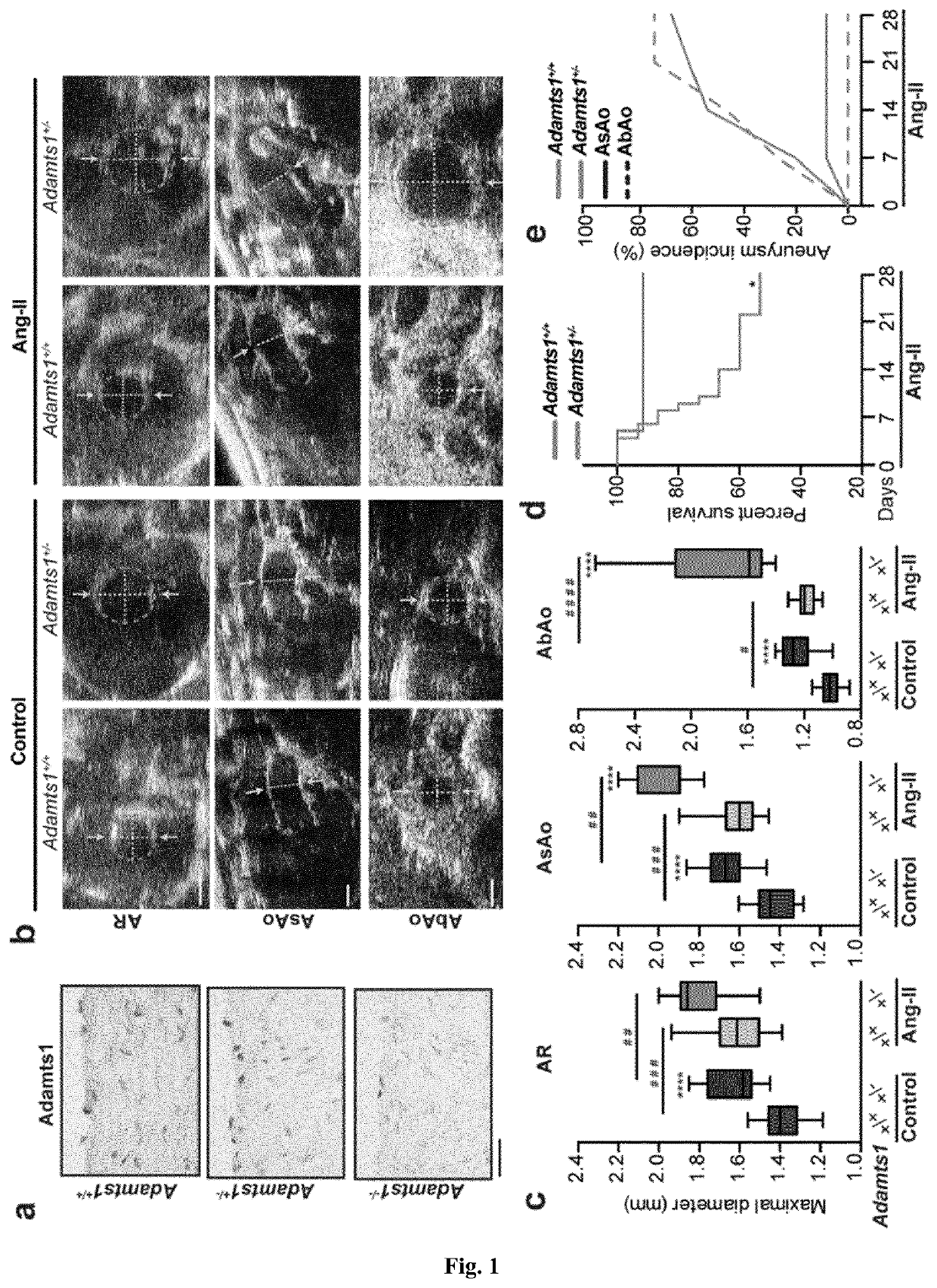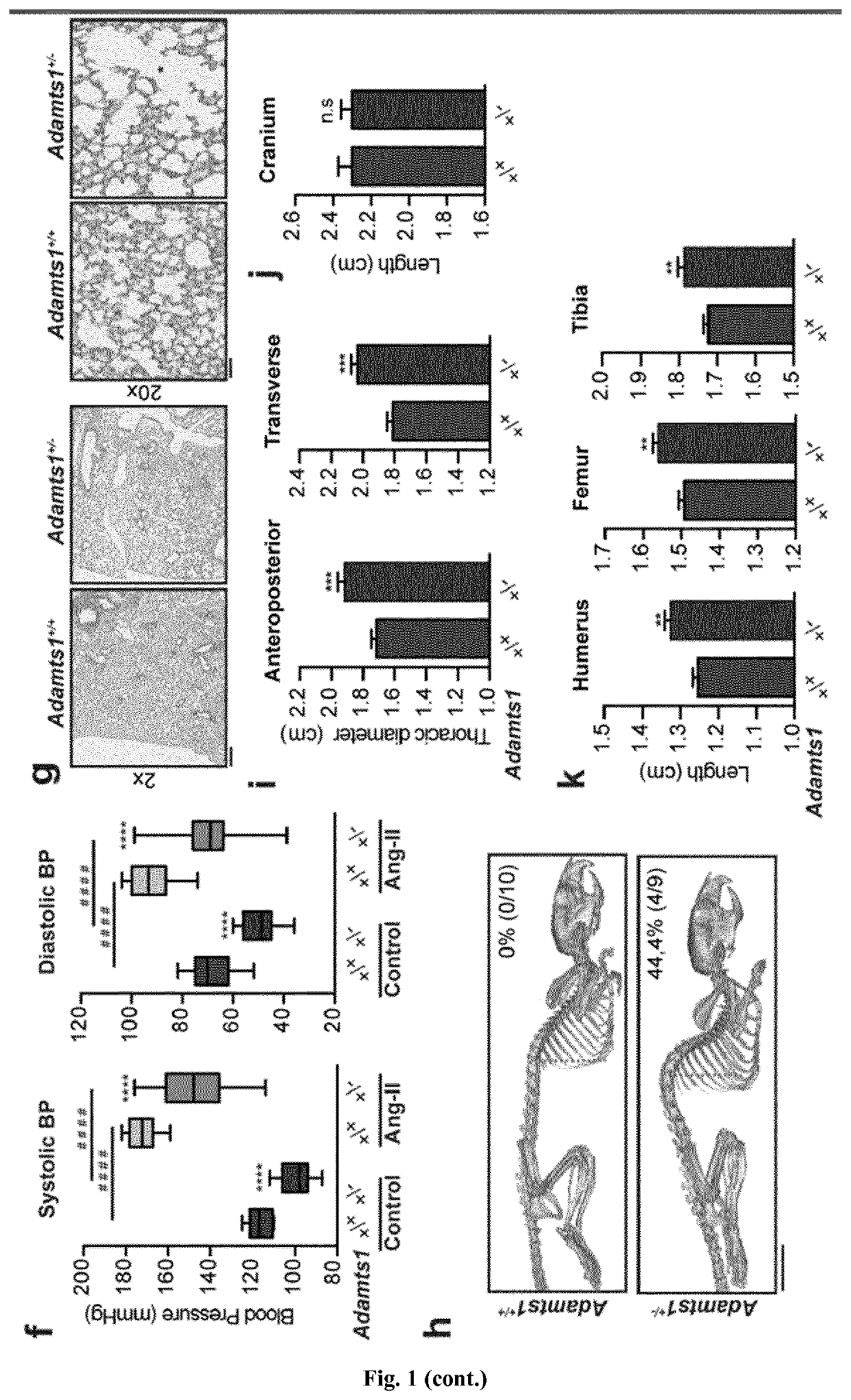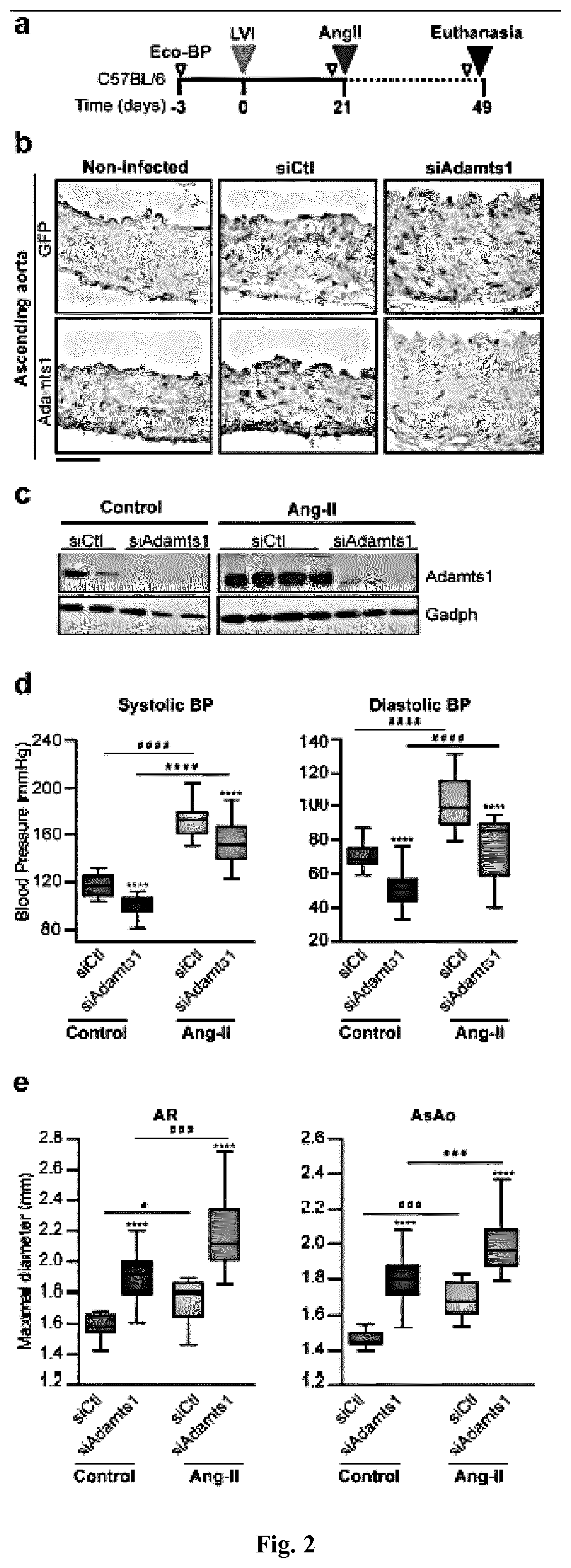In vitro method for identifying thoracic aortic aneurysms (TAA) in a subject
a thoracic aortic aneurysm and in vitro method technology, applied in the field of personalized medicine, can solve the problems of significant morbidity and mortality, losartan is less effective, and atenolol does not produce additional benefits,
- Summary
- Abstract
- Description
- Claims
- Application Information
AI Technical Summary
Benefits of technology
Problems solved by technology
Method used
Image
Examples
example 1
tal Procedures
[0215]Animal Procedures
[0216]Animal procedures were approved by the CNIC Ethics Committee and conformed to European Union guidelines for the care and experimental use of animals. Adamts1+ / − mice were obtained from the European Mouse Mutant Archive [(EM:02291) B6; 129P2-Adamts1 / H] and carried a LacZ-Neo cassette to replace a genomic sequence (c7784) between exon1 and 2 in the Adamts1 target allele. Fbn1C1039G / + mice (Judge et al., 2004), harboring a mutation in the Fbn1 gene, and Nos2− / − mice (Laubach et al., 1995) were obtained from Jackson Laboratories (JAX mice stock #012885 and 007072, respectively). These 3 strains had been previously backcrossed to C57BL / 6 for more than nine generations. All mice were genotyped by PCR of tail samples using the following primers: Adamts1 mice (5′-GCCATCGGGGTCAGCTTTTCAAATG-3′, 5′-GGGCCAGCTCATTCCTCCCACTCAT / GGTTGTAGTTTCGCGCTGAGTTTTG-3′); Nos2− / − mice (5′ ACATGCAGAATGAGTACCGG 3′; 5′ TCAACATCTCCTGGTGGAAC 3′, 5′ AATATGCGAAGTGGACCTCG 3′);...
example 2
ive Adamts1 Deficiency Induces a Syndromic Form of TAA
[0244]To investigate the contribution of Adamts1 to Ang-II-elicited aortic dilation and aneurysm, we used Adamts1 deficient mice from the European Mouse Mutant Archive (EM: 02291). Adamts1+ / − mice expressed lower levels of aortic Adamts1 than wild-type (wt) littermates (FIGS. 1A and 7 A). Adamts1− / − mice were not used because of their very low survival at weaning (FIG. 7B). In contrast, Adamts1+ / − survival was similar to that of wt littermates, and these mice appeared healthy at this stage. Treatment of 8-week-old wt mice with Ang-II for 28 days promoted generalized aortic dilation, confirmed by ultrasonography of the aortic ring (AR), ascending aorta (AsAo) and abdominal aorta (AbAo) (FIGS. 1B-1C). Unexpectedly, inactivation of 1 Adamts1 allele induced aortic dilation in untreated mice, and this effect was exacerbated by Ang-I (FIGS. 1B-1C). In addition, whereas Ang-II barely induced AA or lethal aortic dissections in wt mice, i...
example 3
amts1 Knockdown Promotes TAA
[0247]To investigate the direct effects of Adamts1 depletion on aortic dilation, we knocked down aortic expression in adult mice by transducing the aortic wall with lentivirus encoding Adamts1 specific siRNA. A screen of Adamts1 siRNAs in cultured VSMCs identified the high silencing capacity of siRNA-27 (FIGS. 8A-8B). Lentiviral-driven co-expression of green fluorescent protein (GFP) facilitated assessment of transduction efficiency. Intra-jugular inoculation of lentivirus into C57BL / 6 mice yielded efficient and steady transduction of all aortic wall layers, determined by GFP immunostaining of the AsAo and AbAo aorta 7 weeks later (FIGS. 2A-2B). The expression of Adamts1 was almost undetectable in aortic samples of mice inoculated with lentivirus encoding siRNA-27 (siAdamts1) (FIGS. 2B-2C), even in mice treated with Ang-II for the last 4 weeks (FIGS. 2C and 8C). Indeed, Adamts1 mRNA levels in aortic samples of transduced mice were below those in Adamts1+ / ...
PUM
 Login to View More
Login to View More Abstract
Description
Claims
Application Information
 Login to View More
Login to View More - R&D
- Intellectual Property
- Life Sciences
- Materials
- Tech Scout
- Unparalleled Data Quality
- Higher Quality Content
- 60% Fewer Hallucinations
Browse by: Latest US Patents, China's latest patents, Technical Efficacy Thesaurus, Application Domain, Technology Topic, Popular Technical Reports.
© 2025 PatSnap. All rights reserved.Legal|Privacy policy|Modern Slavery Act Transparency Statement|Sitemap|About US| Contact US: help@patsnap.com



